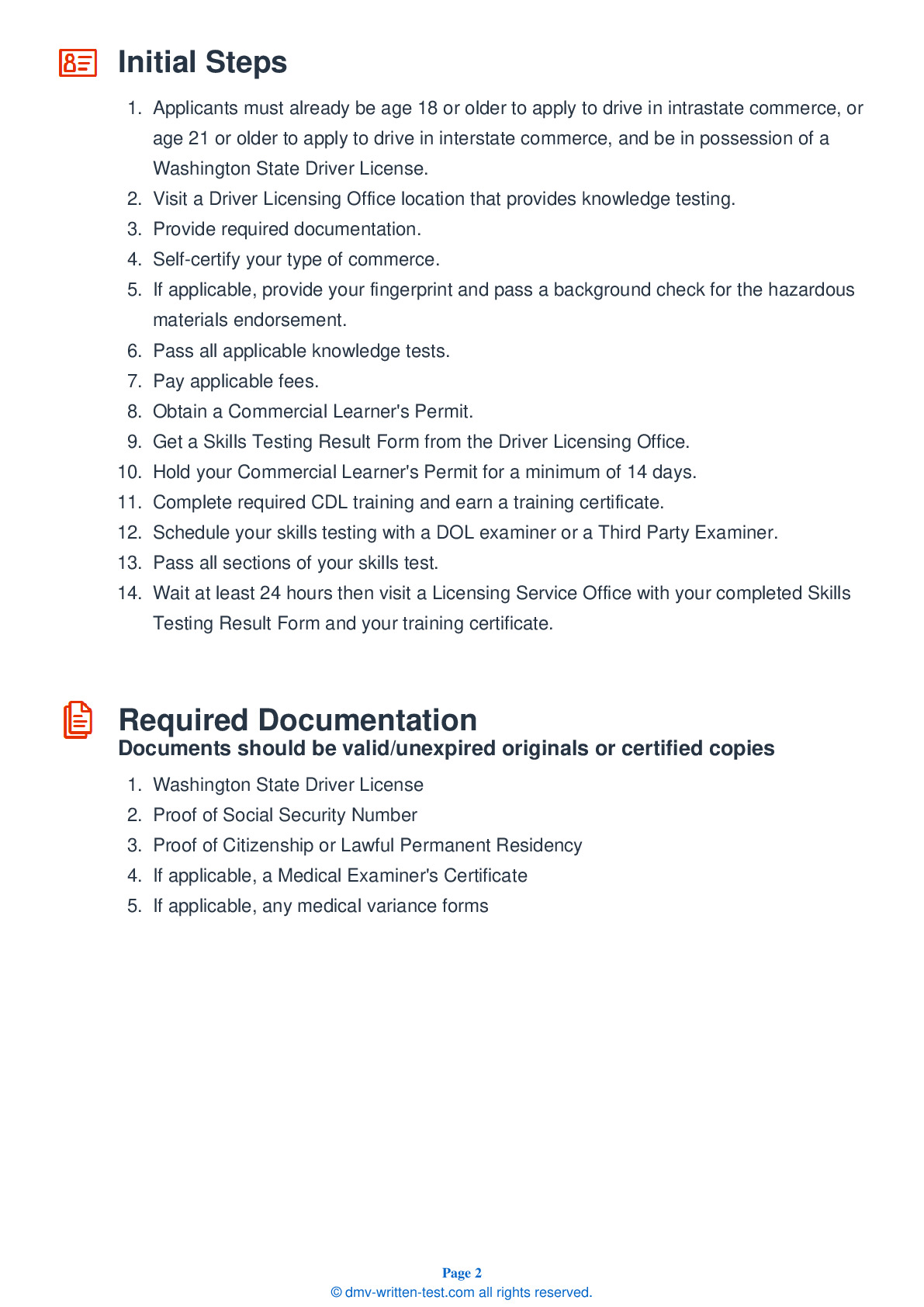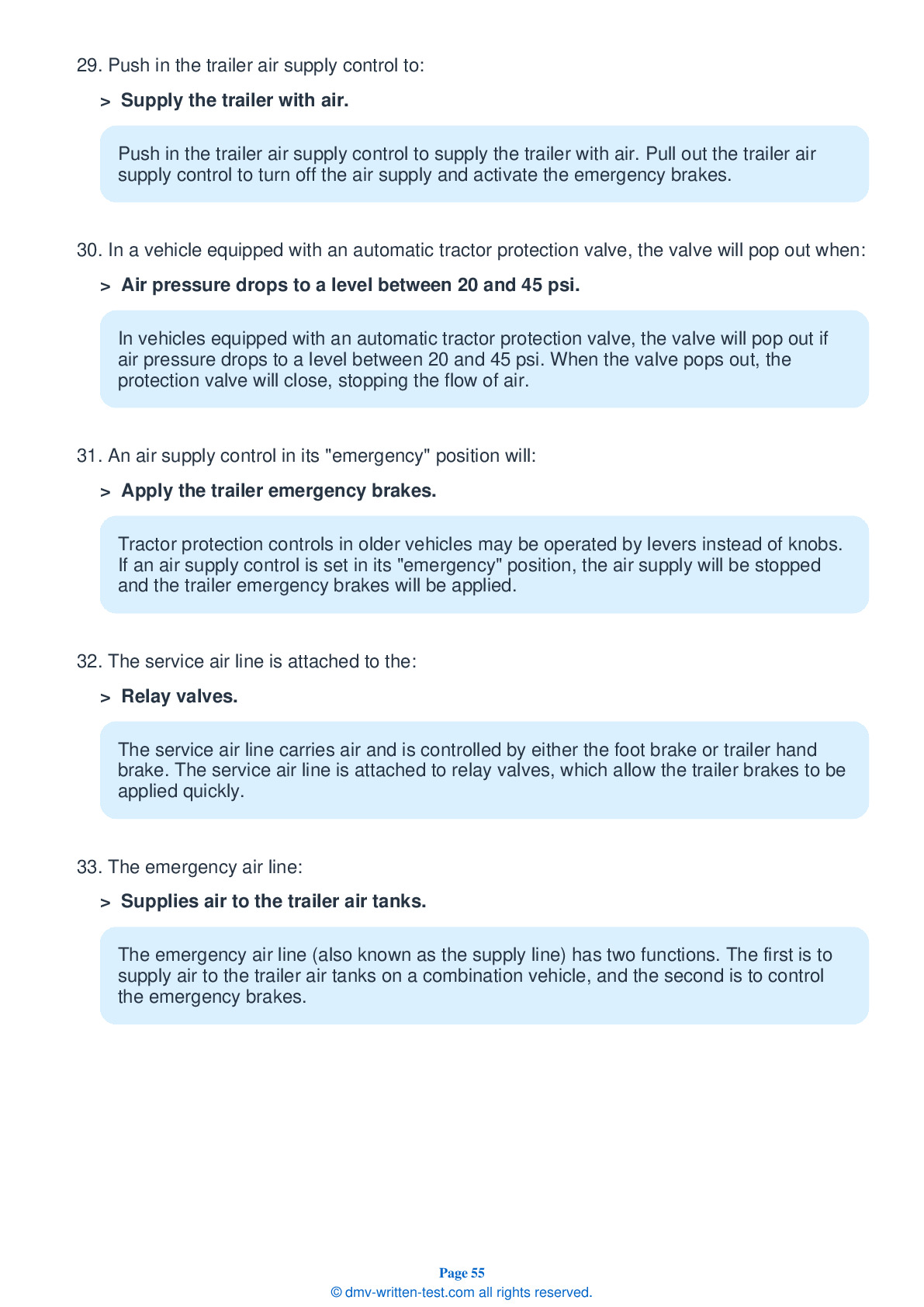Knowledge Test Class A
This license is required for driving any legal combination of vehicles, with a gross combination weight rating of 26,001 pounds or more, provided the GVWR of a trailer exceeds 10,000 pounds. To receive this license, applicants must pass a 50-question test. Test questions come from the Commercial Driver Guide. To pass, applicants must answer 40 questions correctly. Each question has three possible answer choices. Questions come from chapters covering: Introduction, Driving Safely, Transporting Cargo Safely, Air Brakes (if applicable), Combination Vehicles, Pre-Trip Vehicle Inspection Test, Basic Vehicle Control Skills Test and On-Road Driving. Endorsements that may be used with a Class A CDL are: Hazardous materials, Tank, Passenger, Doubles/Triples, HazMat, Tank, Air Brakes and School bus.
29. Cargo inside a trailer:
Cargo inside a trailer must be secured appropriately to prevent it from shifting in transit.
30. If turning to avoid a hazard:
You should not brake while making a quick turn to avoid a hazard. Doing so could cause your wheels to lock and make your vehicle skid out of control.
31. Poisonous fumes can enter a cab due to:
A faulty exhaust system is a serious safety hazard. It may allow poisonous fumes to enter the vehicle's cab or sleeper berth.
32. The two markings on a front brake limiting valve usually read:
Some vehicles with air brake systems manufactured before 1975 have a front brake limiting valve with "normal" and "slippery" settings.
33. If you’re unfamiliar with the area in which you must back up, you should:
Before backing up, you should get out of your vehicle and look at your line of travel. Check your clearance to the sides and overhead.
34. Poor weight balance:
Poorly balanced cargo can cause a vehicle to be difficult to handle. Keep weight distribution in mind when loading cargo.
35. Hanging meat as cargo is usually:
A cargo of hanging meat can be very unstable, both because the meat swings about in transit and because its center of gravity is high.
Frequently Asked Questions
- Tractor-trailers
- Truck and trailer combinations
- Livestock carriers
- Tanker trucks
- Flatbed trucks with attached trailers
- Large buses with trailers
It's important to note that you may be required to obtain additional endorsements or certifications to operate certain types of vehicles, such as hazardous materials (HazMat) or passenger-carrying vehicles.
1. Be at least 18 years of age (21 years of age for interstate driving)
2. Possess a valid Washington State driver's license
3. Obtain a Department of Transportation (DOT) medical certification that you are physically qualified to operate a commercial motor vehicle
4. Pass a series of written knowledge tests covering general knowledge, air brakes, and combination vehicles
5. Obtain a learner's permit by passing a vision test and paying the required fees
6. Complete behind-the-wheel training with a qualified instructor or take a CDL training course.
7. Pass a skills test that includes pre-trip inspection, basic vehicle control, and on-road driving test
It's important to note that additional endorsements or certifications may be required for certain types of vehicles or cargo, such as hazardous materials or passenger-carrying vehicles.
The following are the common endorsements for a Class A CDL license:
1. Hazmat endorsement (H) - This endorsement is required if you will be transporting hazardous materials.
2. Tanker endorsement (N) - This endorsement is required if you will be transporting liquids or gases in bulk containers.
3. Doubles/triples endorsement (T) - This endorsement is required if you will be operating double or triple trailers.
4. Passenger endorsement (P) - This endorsement is required if you will be operating a vehicle designed to transport 16 or more passengers, including the driver.
5. School bus endorsement (S) - This endorsement is required if you will be operating a school bus.
To obtain an endorsement, you must pass a written knowledge test specific to that endorsement and sometimes a skills test as well.
1. Pre-trip inspection: You will be required to perform a thorough inspection of the vehicle to ensure it is safe to operate. You will be tested on your ability to identify and explain any potential safety hazards or defects.
2. Basic vehicle control: You will be tested on your ability to perform basic maneuvers such as backing up, turning, and parking in a designated area. You will be evaluated on your control of the vehicle and your ability to follow traffic laws and signals.
3. On-road driving: You will be evaluated on your ability to safely operate the commercial motor vehicle in traffic, including merging, changing lanes, turning at intersections, and responding to traffic signals. The examiner will also assess your ability to make safe decisions in various driving situations.
The skills test must be taken in a vehicle that is representative of the type of commercial motor vehicle you will be driving with your Class A CDL license. It is important to practice and prepare for the skills test by studying the Washington State Commercial Driver Guide, obtaining proper training from a CDL training school or program, and practicing with a qualified instructor or mentor.
The following are the common restrictions and limitations for Class A CDL drivers:
1. Age restrictions: If you are under 21 years old, you are not allowed to operate a commercial motor vehicle across state lines or transport hazardous materials.
2. Endorsement restrictions: If you do not have the required endorsements for a specific type of vehicle or cargo, you are not allowed to operate that vehicle or transport that cargo.
3. Medical qualifications: If you have certain medical conditions or take certain medications, you may be required to obtain a medical waiver or restriction on your CDL license.
4. Vehicle-specific restrictions: Some commercial motor vehicles may have specific restrictions or requirements based on their size, weight, or other factors. For example, some vehicles may require additional training or special permits.
5. Time-of-day restrictions: Some states may have time-of-day restrictions on certain types of commercial motor vehicles based on traffic patterns and safety concerns.
It is important to review the Washington State Commercial Driver Guide and any additional state or federal regulations to ensure compliance with all restrictions and limitations that apply to your Class A CDL license.
To take the written test in a language other than English, you must schedule an appointment at a DOL testing center that offers the test in your preferred language. You will need to bring identification documents and pay the required fees for the test.
It is important to note that while you may take the written test in a language other than English, you will still be required to demonstrate proficiency in English for the skills test and for communication with law enforcement and other officials while operating a commercial motor vehicle.
To request accommodations, you must complete and submit the DOL's Request for Reasonable Accommodation form. This form is available on the DOL's website or can be obtained by contacting the DOL.
The form requires you to provide information about your disability and the specific accommodations you are requesting. You may be required to provide medical documentation or other supporting documentation to verify your disability and need for accommodations.
Examples of accommodations that may be provided include extended time for taking the test, a separate testing room, or assistive technology such as a screen reader or magnifier.
Once your request has been received and reviewed, the DOL will notify you of its decision regarding your request for accommodations. If your request is approved, you will be provided with instructions on how to schedule your test with the requested accommodations.
There is a fee for each attempt at the written test, so it is important to be well-prepared before taking the test. You can study for the Class A CDL written test by reviewing the Washington State Commercial Driver Guide, which is available on the Washington State Department of Licensing (DOL) website.
If you have difficulty passing the written test, consider seeking additional resources to help you prepare, such as a CDL training program or practice tests. It is important to note that passing the written test is only one step in obtaining your Class A CDL. You will also need to pass a skills test that includes a pre-trip inspection, basic control skills and a road test.




